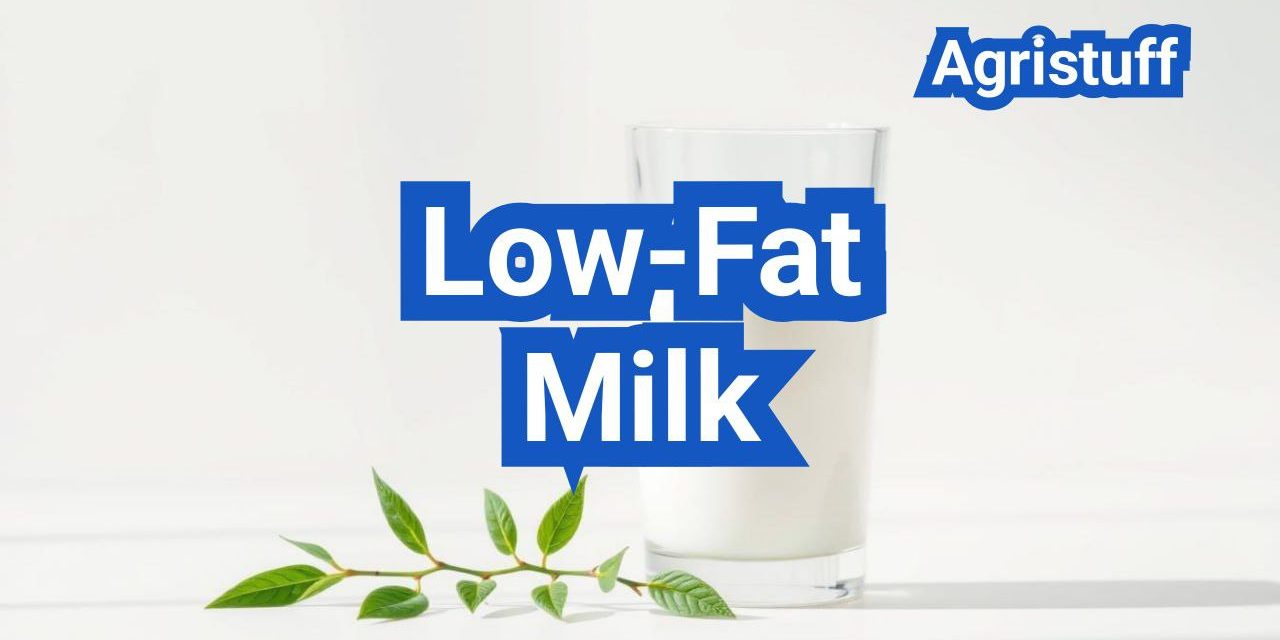This article does not contain medical advice
Low-fat milk has become a staple in many American households, touted for its potential health benefits.
According to Medical News Today, it is a rich source of essential nutrients like protein, vitamins, and minerals. For those looking to manage their calorie intake, low fat milk can be an attractive option.
However, it’s crucial to weigh the advantages and disadvantages of incorporating low-fat milk into your diet. This article will explore the nutritional content, benefits, and potential drawbacks of low-fat milk, helping you make an informed decision about whether it’s the right choice for you.
Key Takeaways
- Low-fat milk is a good source of protein, vitamins, and minerals.
- It can be a suitable option for those managing their calorie intake.
- The nutritional content of low-fat milk varies depending on the brand and type.
- Some people may experience digestive issues with low-fat milk consumption.
- It’s essential to weigh the pros and cons before making it a part of your diet.
Understanding Low-Fat Milk: What It Actually Means
The term ‘low-fat milk’ is often used, but understanding its definition is crucial for making informed dietary choices. Low-fat milk is defined by its fat content, which is significantly lower than that of whole milk.
Definition and Processing Methods
Low fat milk is produced by reducing the fat content of whole milk through a process known as skimming. This involves removing some or most of the cream, which contains a significant portion of the milk’s fat.
The processing method can vary, but it typically involves centrifugation or skimming to separate the cream from the skim milk. The resulting product is then standardized to achieve the desired fat content.
FDA Standards for Milk Fat Content
The FDA sets standards for milk fat content, defining the different categories of milk based on their fat percentage. According to FDA regulations, low-fat milk must contain between 0.5% and 2% fat.
This standardization ensures that consumers know what to expect when purchasing low-fat milk, providing a consistent product across different brands.
How Low-Fat Milk Is Produced
The production of low fat milk involves several steps, starting with the collection of whole milk from dairy farms. The milk is then processed to remove some of the fat, resulting in a product that meets the FDA’s standards for low-fat milk.
The exact process can vary between manufacturers, but it generally involves a combination of skimming and standardization to achieve the desired fat content.
The Nutritional Profile of Low-Fat Milk
Understanding the nutritional profile of low-fat milk is crucial for making informed dietary choices. Low-fat milk is a rich source of essential nutrients, making it a popular choice among health-conscious consumers.
Complete Nutrition Facts Breakdown
Low-fat milk is an excellent source of protein, calcium, and vitamins D and B12. A typical serving provides a significant portion of the daily recommended intake of these nutrients. The exact nutritional content can vary slightly depending on the brand and type of low-fat milk.
Calories in Low-Fat Milk Per Cup
One cup of low-fat milk typically contains around 100-150 calories, with the exact number depending on the fat percentage (1% or 2%). This makes it a relatively low-calorie beverage option compared to whole milk or other dairy products.
Protein, Carbohydrates, and Fat Content
Low-fat milk contains a balanced mix of protein, carbohydrates, and fat. The protein content supports muscle health, while the carbohydrates provide energy. The reduced fat content makes it an attractive option for those monitoring their fat intake.
Vitamins and Minerals
Low-fat milk is fortified with vitamins A and D, and it naturally contains calcium, potassium, and magnesium. These nutrients are vital for bone health, heart function, and overall well-being. The vitamin D in low-fat milk enhances calcium absorption, supporting bone density.
In summary, low-fat milk offers a nutrient-rich profile that can be a valuable part of a balanced diet. Its combination of protein, calcium, and vitamins makes it an excellent choice for those seeking to improve their nutritional intake without consuming high amounts of fat.
Low-Fat Milk vs. Whole Milk: A Comprehensive Comparison

Understanding the differences between low-fat milk and whole milk is crucial for making informed dietary choices. Both types of milk have their own set of benefits and drawbacks, which are discussed in detail below.
Calorie and Fat Content Differences
One of the primary differences between low-fat milk and whole milk is their calorie and fat content. Whole milk contains more calories and saturated fat compared to low-fat milk.
| Milk Type | Calories per Cup | Fat Content |
|---|---|---|
| Whole Milk | 170 | 8g |
| Low-Fat Milk (2% fat) | 120 | 4.5g |
As shown in the table, whole milk has a higher calorie and fat content compared to low-fat milk.
Taste and Texture Variations
The taste and texture of milk are significantly affected by its fat content. Whole milk is often described as richer and creamier, while low-fat milk is lighter and more watery.
The difference in taste and texture can influence consumer preference, with some people preferring the richer taste of whole milk and others opting for the lighter taste of low-fat milk.
Satiety Factors
The fat content in milk also affects its satiety factor. Whole milk, with its higher fat content, tends to be more satiating than low-fat milk.
Satiety Comparison: Research suggests that the higher fat content in whole milk can lead to greater feelings of fullness, potentially aiding in weight management.
Price Considerations
The price of low-fat milk and whole milk can vary depending on the brand and location. Generally, both types of milk are similarly priced, but prices can fluctuate based on factors like organic certification and local dairy regulations.
- Conventional whole milk and low-fat milk are usually priced similarly.
- Organic options tend to be more expensive.
- Local dairy products might offer better value.
1% vs. 2% Milk: Understanding the Differences
1% and 2% milk are two popular low-fat milk options that differ primarily in their fat content. This difference in fat content affects not only their nutritional profiles but also their taste and uses in cooking and baking.
Nutritional Comparison
The primary distinction between 1% and 2% milk is the fat content, with 1% milk containing less fat. A cup of 1% milk typically contains around 110 calories, 2.9 grams of fat, and 13 grams of protein. In contrast, a cup of 2% milk contains about 120 calories, 4.7 grams of fat, and 12 grams of protein. Both types of milk are good sources of calcium, vitamin D, and other essential nutrients.
When comparing the nutritional profiles, it’s clear that 2% milk has a slightly higher calorie and fat content due to its higher fat percentage. However, both options are considered low-fat and can be part of a healthy diet.
Taste Profile Differences
The taste difference between 1% and 2% milk is subtle but noticeable. 2% milk has a richer, creamier taste due to its higher fat content, while 1% milk is slightly lighter and less creamy. The taste variation can impact the overall flavor of recipes and beverages made with these milks.
Best Uses in Cooking and Baking
Both 1% and 2% milk can be used in a variety of recipes, from baking to cooking. However, the choice between them may depend on the desired texture and flavor of the final product. For instance, 2% milk might be preferred for recipes where a richer texture is desired, such as in creamy soups or baked goods. On the other hand, 1% milk is suitable for those looking to reduce fat content without significantly altering the recipe’s overall character.
In conclusion, while both 1% and 2% milk are nutritious options, their differences in fat content, taste, and usage can guide consumers in making the best choice for their dietary needs and preferences.
Skim Milk vs. Low-Fat Milk: Which Is Right for You?

The choice between skim milk and low-fat milk depends on several factors, including nutritional needs and taste preferences. Both types of milk have their unique benefits and drawbacks.
Nutritional Differences
Skim milk and low-fat milk differ significantly in their fat content. Skim milk has virtually no fat, while low-fat milk contains a small amount of fat. This difference affects their nutritional profiles.
- Skim milk: 0-1g fat per cup, approximately 80-100 calories
- Low-fat milk: 2-3g fat per cup, approximately 100-150 calories
The fat content in low-fat milk can aid in the absorption of fat-soluble vitamins like vitamins A, D, E, and K. On the other hand, skim milk is ideal for those who are watching their calorie and fat intake closely.
Taste and Mouthfeel Comparison
The taste and mouthfeel of skim milk and low-fat milk vary due to their different fat contents. Low-fat milk tends to have a richer taste and creamier texture compared to skim milk.
Some key differences include:
- Low-fat milk has a more satisfying mouthfeel, making it preferable for those who find skim milk too watery.
- Skim milk, while less creamy, is still a good source of high-quality protein and calcium.
Who Benefits Most from Each Type
Understanding who benefits most from each type can help in making an informed decision.
- Skim milk is suitable for those on a very low-fat diet, individuals with heart health concerns, and those managing their weight.
- Low-fat milk is a good option for those who want a balance between reduced fat content and richer taste, and for individuals who need the extra calories for energy.
In conclusion, the choice between skim milk and low-fat milk should be based on individual nutritional needs, taste preferences, and health goals.
The Health Benefits of Low-Fat Milk
Low-fat milk is rich in essential nutrients that provide various health benefits. It is an excellent source of calcium, vitamin D, and high-quality protein, making it a valuable component of a healthy diet.
Calcium and Vitamin D Absorption
One of the primary health benefits of low-fat milk is its role in supporting bone health through calcium and vitamin D absorption. Calcium is crucial for building and maintaining strong bones and teeth, while vitamin D helps the body absorb calcium more effectively. Together, they play a significant role in preventing osteoporosis and fractures, particularly in older adults.
As noted by a study published in the Journal of Bone and Mineral Research, “Vitamin D and calcium supplementation reduced the risk of fractures in older adults.” This highlights the importance of adequate calcium and vitamin D intake through sources like low-fat milk.
Protein Quality and Quantity
Low-fat milk is also an excellent source of high-quality protein, containing all essential amino acids necessary for various bodily functions. Protein is vital for muscle repair, growth, and overall body maintenance. Consuming adequate protein can also help with weight management by promoting satiety and reducing the likelihood of overeating.
- Supports muscle health and repair
- Promotes satiety and weight management
- Essential for overall bodily functions
Reduced Saturated Fat Intake
Choosing low-fat milk over whole milk can significantly reduce saturated fat intake. High consumption of saturated fats is associated with an increased risk of heart disease. By opting for low-fat milk, individuals can enjoy the nutritional benefits of milk while minimizing their saturated fat intake.
“Reducing saturated fat consumption is a key dietary recommendation for lowering the risk of cardiovascular disease.” – American Heart Association
Research-Backed Health Benefits
Numerous studies have highlighted the health benefits associated with low-fat milk consumption. These benefits include improved bone density, reduced risk of cardiovascular disease, and support for healthy weight management. By incorporating low-fat milk into their diet, individuals can reap these rewards and support their overall health and well-being.
| Health Benefit | Description |
|---|---|
| Improved Bone Density | Calcium and vitamin D support strong bones |
| Reduced Cardiovascular Risk | Lower saturated fat intake |
| Healthy Weight Management | High-quality protein promotes satiety |
How to Incorporate Low-Fat Milk into Your Diet

Incorporating low-fat milk into your diet can be a simple yet effective way to improve your overall nutrition. Low-fat milk is rich in essential nutrients like calcium, vitamin D, and protein, making it a great addition to a balanced diet.
Daily Consumption Guidelines
The daily recommended intake of dairy varies by age and dietary needs. Generally, adults are advised to consume 2-3 cups of dairy products per day, with low-fat or fat-free milk being excellent choices. “Drinking milk is an easy way to get essential nutrients, including calcium, vitamin D, and potassium,” according to dietary guidelines.
For those who are lactose intolerant or prefer non-dairy alternatives, fortified plant-based milks can be a suitable substitute. However, it’s essential to check the nutrition label to ensure they are fortified with similar nutrients found in dairy milk.
Recipe Substitutions and Cooking Tips
Low-fat milk can be used as a direct substitute in most recipes that call for whole milk or other dairy products. When cooking or baking, using low-fat milk can significantly reduce the calorie and fat content of your dishes. For instance, you can use it to make creamy soups, sauces, or baked goods like muffins and cakes.
Cooking Tips:
- Use low-fat milk to make a creamy base for soups and sauces.
- Substitute whole milk with low-fat milk in baking recipes.
- Add low-fat milk to oatmeal or cereal for a nutritious breakfast.
Pairing with Other Foods for Maximum Nutrition
Low-fat milk pairs well with a variety of nutrient-dense foods, enhancing the nutritional value of your meals. For example, combining low-fat milk with whole grain cereals or oatmeal provides a balanced mix of carbohydrates, protein, and fiber.
“The combination of low-fat milk with nutrient-rich foods like whole grains and fruits can help support overall health and well-being.”
Additionally, low-fat milk can be used in smoothies with fruits and vegetables, providing a refreshing and healthy beverage option. It’s also a great accompaniment to meals or as a post-workout recovery drink.
By incorporating low-fat milk into your diet, you can enjoy its numerous health benefits while maintaining a balanced and varied eating plan.
Low-Fat Milk for Weight Management

For those looking to manage their weight, low-fat milk can be a valuable addition to their dietary regimen. Low-fat milk offers a nutrient-rich beverage option that can support weight loss efforts while providing essential vitamins and minerals.
Calorie Reduction Strategies
One of the primary ways low-fat milk supports weight management is through calorie reduction. Compared to whole milk, low-fat milk contains fewer calories, making it an attractive option for those monitoring their calorie intake. By substituting whole milk with low-fat milk, individuals can reduce their overall calorie consumption, which is a crucial factor in weight loss.
For example, a cup of whole milk contains approximately 170 calories, while a cup of low-fat milk (2% fat) contains about 120 calories. This reduction in calorie intake can contribute to a calorie deficit, which is essential for weight loss.
Protein Satiety Benefits
Low-fat milk is also rich in protein, which plays a significant role in promoting satiety. The protein content in low-fat milk can help individuals feel fuller for longer, reducing the likelihood of overeating or snacking between meals. This satiety effect is particularly beneficial for those trying to manage their weight.
Research has shown that high-protein diets can lead to greater weight loss and improved weight maintenance over time. As low-fat milk is a good source of protein, incorporating it into one’s diet can be a useful strategy for enhancing satiety and supporting weight management goals.
Research on Dairy and Weight Loss
Numerous studies have investigated the relationship between dairy consumption and weight loss. Some research suggests that dairy products, including low-fat milk, may have a positive impact on weight management due to their nutrient profile and satiety-promoting effects.
A comprehensive review of studies on dairy and weight loss found that participants who consumed dairy products as part of a calorie-restricted diet tended to lose more weight than those who did not consume dairy. While more research is needed to fully understand the mechanisms involved, the available evidence supports the inclusion of low-fat milk in a weight loss diet.
Practical Incorporation into Weight Loss Diets
To effectively incorporate low-fat milk into a weight loss diet, consider the following tips:
- Use low-fat milk as a base for smoothies, adding fruits and vegetables for added nutrition.
- Substitute low-fat milk for whole milk in recipes and cooking.
- Enjoy low-fat milk as a beverage on its own or with a sprinkle of cinnamon or cocoa powder for flavor.
- Combine low-fat milk with oatmeal or cereal for a filling breakfast.
By incorporating low-fat milk into daily meals and snacks, individuals can harness its nutritional benefits to support their weight management goals.
Low-Fat Milk for Cholesterol Management

For individuals concerned about their cholesterol levels, understanding the role of low-fat milk in their diet can be beneficial. Low-fat milk is often considered a healthier alternative to whole milk due to its lower saturated fat content, which can contribute to improved heart health.
Impact on LDL Cholesterol Levels
Consuming low-fat milk can help reduce the intake of saturated fats, which are known to potentially increase LDL cholesterol levels. LDL cholesterol, often referred to as “bad” cholesterol, can lead to plaque buildup in arteries, increasing the risk of cardiovascular diseases. By choosing low-fat milk, individuals can make a dietary adjustment that may help in managing their LDL cholesterol levels.
Saturated Fat Content and Heart Health
The saturated fat content in whole milk can be a concern for heart health. In contrast, low-fat milk contains less saturated fat, making it a preferable choice for those looking to reduce their saturated fat intake. This reduction is significant because high saturated fat consumption is linked to an increased risk of heart disease.
Research on Dairy and Cardiovascular Risk
Numerous studies have investigated the relationship between dairy consumption and cardiovascular health. Some research suggests that moderate consumption of low-fat dairy products, like low-fat milk, may be associated with a reduced risk of cardiovascular disease. However, it’s essential to consider the overall dietary pattern and lifestyle when evaluating the impact of low-fat milk on heart health.
In conclusion, incorporating low-fat milk into one’s diet can be a part of a broader strategy for managing cholesterol levels and supporting heart health. By understanding the benefits and limitations of low-fat milk, individuals can make informed dietary choices.
Popular Low-Fat Milk Brands in the U.S. Market

When it comes to low-fat milk, U.S. consumers are spoiled for choice, with both national and store brands offering a variety of options. The market is saturated with brands that cater to different tastes, dietary needs, and budget considerations.
National Brands and Their Offerings
National brands such as Organic Valley and Daisy are well-known for their low-fat milk products. These brands often emphasize quality and nutritional value, with some offering organic options. For instance, Organic Valley’s low-fat milk is made from the milk of cows that are not treated with rBGH (recombinant bovine growth hormone), appealing to consumers looking for more natural dairy products.
Store Brands Like Great Value
Store brands, such as Great Value from Walmart, offer affordable alternatives without compromising on quality. Great Value’s low-fat milk is a popular choice among budget-conscious consumers, providing a similar nutritional profile to national brands at a lower price point.
Organic and Specialty Options
For consumers seeking organic or specialty low-fat milk, brands like Horizon Organic and Silk offer a range of products. These can include not only organic low-fat milk but also plant-based alternatives for those with dietary restrictions or preferences.
Price Comparison and Value
When choosing a low-fat milk brand, price is a significant factor. National brands tend to be pricier than store brands, but they often come with the assurance of quality and specific production standards. A price comparison across different brands reveals that store brands like Great Value can offer substantial savings. For example, a gallon of Great Value low-fat milk can cost significantly less than a gallon from a national brand like Organic Valley.
In conclusion, the U.S. market for low-fat milk is diverse, with a range of options available to suit different consumer needs. Whether prioritizing organic certification, budget, or brand reputation, consumers have numerous choices.
Special Populations: Who Should Choose Low-Fat Milk

Certain populations can particularly benefit from incorporating low-fat milk into their diets. Low-fat milk offers a nutrient-rich profile that can support the health needs of diverse groups.
Children Over Age 2
For children over the age of 2, low-fat milk is recommended as it provides essential nutrients like calcium and vitamin D necessary for bone growth and development. The American Academy of Pediatrics suggests transitioning to low-fat or fat-free milk after age 2 to reduce saturated fat intake.
Adults with Cardiovascular Risk Factors
Adults with cardiovascular risk factors can benefit from the reduced saturated fat content in low-fat milk. Studies have shown that consuming low-fat dairy products can help manage cholesterol levels and lower blood pressure.
Athletes and Active Individuals
Athletes and active individuals require a diet rich in protein to support muscle repair and recovery. Low-fat milk is an excellent source of high-quality protein, making it a great post-workout beverage option.
Older Adults and Bone Health
Older adults can benefit from the calcium and vitamin D in low-fat milk, which are crucial for maintaining bone density and preventing osteoporosis. Consuming low-fat milk regularly can help reduce the risk of fractures and support overall bone health.
In conclusion, low-fat milk is a versatile beverage that can cater to the nutritional needs of various special populations, from children to older adults, and everyone in between.
Lactose-Free Low-Fat Milk Options

For individuals with lactose intolerance, lactose-free low-fat milk presents a valuable alternative. This type of milk is produced by either removing lactose or breaking it down into simpler sugars, making it easier to digest for those with lactose intolerance.
Production Process of Lactose-Free Milk
The production of lactose-free milk involves a few key steps. First, milk is sourced from dairy farms. Then, the lactose is either removed through ultrafiltration or broken down using the enzyme lactase. This enzyme splits lactose into glucose and galactose, making the milk more digestible for individuals with lactose intolerance.
Lactase enzyme treatment is a common method used in the production of lactose-free milk. This process ensures that the milk retains its nutritional value while becoming more accessible to a wider audience.
Nutritional Differences from Regular Low-Fat Milk
Lactose-free low-fat milk has a similar nutritional profile to regular low-fat milk, with the primary difference being the absence or reduction of lactose. The calcium, vitamin D, and protein content remain largely the same, making it an excellent option for those who still want to benefit from the nutritional value of milk without the discomfort of lactose intolerance.
In some cases, lactose-free milk may have a slightly sweeter taste due to the breakdown of lactose into simpler sugars. However, this does not significantly affect its nutritional content.
Top Brands and Options in the U.S.
Several brands offer lactose-free low-fat milk in the U.S. market. Some of the top brands include:
- Lactaid
- Organic Valley
- Dairy Pure
These brands provide a range of lactose-free products, including low-fat options, catering to different consumer preferences and dietary needs.
Common Misconceptions About Low-Fat Milk

Low-fat milk is often subject to misconceptions that can affect how it’s perceived in a healthy diet. Many consumers believe that low-fat or fat-free versions of dairy products are always the healthier choice. However, this isn’t always the case, as some products may contain added sugars or undergo significant processing that can impact their nutritional value.
The “Fat-Free Is Always Healthier” Myth
The notion that fat-free is always healthier stems from the association between dietary fat and cardiovascular health. While it’s true that excessive saturated fat consumption can be harmful, completely eliminating fat from dairy products isn’t necessarily beneficial. Some fat is needed for the absorption of vitamins, and removing it can lead to other nutritional imbalances.
Added Sugars in Flavored Low-Fat Milk
One of the significant concerns with flavored low-fat milk is the potential for added sugars. Consumers often opt for flavored versions to make their milk consumption more enjoyable, but these products can contain as much sugar as soft drinks. It’s crucial to check the nutrition label and choose unsweetened or naturally flavored versions to avoid excessive sugar intake.
Processing and Nutritional Value Myths
There’s a common misconception that heavily processed foods, including low-fat milk, are nutritionally inferior. While it’s true that processing can affect the nutritional content, many low-fat milk products are fortified with vitamins and minerals that enhance their nutritional profile. The key is to choose products that are minimally processed and enriched with beneficial nutrients.
| Nutritional Aspect | Low-Fat Milk | Whole Milk |
|---|---|---|
| Calories per Cup | 100-110 | 170 |
| Fat Content | 0-2g | 8g |
| Calcium Content | 300mg | 300mg |
The Full-Fat Dairy Trend: Examining the Evidence
In recent years, there’s been a trend towards consuming full-fat dairy products, driven by research suggesting that full-fat dairy may not be as harmful as previously thought, and could even have health benefits. However, it’s essential to consider the overall dietary context and individual health needs. For some, low-fat milk remains a healthier choice, particularly for those managing calorie or saturated fat intake.
By understanding the facts and dispelling common misconceptions, consumers can make more informed choices about their dairy consumption, aligning with their health goals and dietary preferences.
The Trade-Offs: What You’re Giving Up with Low-Fat Milk
Opting for low-fat milk may seem like a healthy choice, but it’s crucial to understand what you’re giving up. While it offers several health benefits, there are potential trade-offs to consider when choosing low-fat milk over whole milk.
Fat-Soluble Vitamin Absorption
One of the primary concerns with low-fat milk is its impact on the absorption of fat-soluble vitamins, including vitamins A, D, E, and K. These vitamins are crucial for various bodily functions, such as maintaining healthy vision, immune function, and bone health.
- Vitamin A: Important for vision and immune function
- Vitamin D: Crucial for bone health and calcium absorption
- Vitamin E: Acts as an antioxidant, protecting cells from damage
- Vitamin K: Essential for blood clotting and bone health
Reducing the fat content in milk may decrease the absorption of these vitamins, potentially leading to deficiencies over time.
Satiety and Fullness Factors
Another trade-off is the potential reduction in satiety and fullness. Whole milk contains more fat, which can help individuals feel fuller for longer. In contrast, low-fat milk may not be as satiating, potentially leading to increased calorie intake from other sources.
Taste and Culinary Applications
The taste and texture of low-fat milk differ significantly from whole milk, which can affect its use in cooking and baking. Some recipes may not turn out as well with low-fat milk due to its lower fat content, potentially altering the final product’s taste and texture.
For instance, cream-based sauces and baked goods often rely on the richness of whole milk to achieve the desired consistency and flavor.
Whole Food Philosophy Considerations
Lastly, choosing low-fat milk may conflict with the principles of a whole food philosophy, which emphasizes consuming foods in their most natural state. Processing milk to reduce its fat content can be seen as altering its natural composition.
Proponents of whole foods argue that consuming dairy products in their natural form, including the fat, is more beneficial for overall health.
Making the Right Milk Choice for Your Health Goals
Choosing the right type of milk can be a crucial decision for achieving your health goals. Low-fat milk offers several benefits, including reduced saturated fat intake and high-quality protein. When deciding between low-fat milk and other types of milk, consider your individual nutritional needs and health objectives.
For those looking to manage their weight or cholesterol levels, low-fat milk can be a valuable addition to their diet. The calcium and vitamin D in low-fat milk also support bone health, making it a good choice for older adults and children over age 2. Ultimately, making the right milk choice involves balancing your nutritional requirements with your personal preferences and health goals.
By understanding the nutritional profiles and benefits of different milk types, you can make an informed decision that aligns with your overall health and wellness strategy. Whether you opt for low-fat milk or another variety, the key is to choose a milk that supports your health goals and fits your lifestyle.
FAQ
What is low-fat milk?
Low-fat milk is milk that has been processed to reduce its fat content, typically to 1% or 2% fat.
How is low-fat milk produced?
Low-fat milk is produced by removing some or all of the cream from whole milk, resulting in a lower fat content.
What are the nutritional benefits of low-fat milk?
Low-fat milk is a good source of protein, calcium, and vitamins D and B12, while being lower in calories and saturated fat compared to whole milk.
Is low-fat milk suitable for weight loss?
Yes, low-fat milk can be a helpful addition to a weight loss diet due to its lower calorie count and high protein content, which can help with satiety.
Can low-fat milk help with cholesterol management?
Yes, low-fat milk can help reduce saturated fat intake and potentially lower LDL cholesterol levels, supporting heart health.
What is the difference between 1% and 2% milk?
The main difference is the fat content, with 1% milk having less fat than 2% milk. The nutritional profiles and uses in cooking and baking also vary slightly.
Is skim milk the same as low-fat milk?
No, skim milk has almost no fat, while low-fat milk typically contains 1% or 2% fat. Both have their own nutritional benefits and uses.
Are there any special populations that should choose low-fat milk?
Yes, children over age 2, adults with cardiovascular risk factors, athletes, and older adults may benefit from choosing low-fat milk as part of a balanced diet.
What is lactose-free low-fat milk?
Lactose-free low-fat milk is milk that has been processed to remove lactose, making it suitable for those with lactose intolerance, while still being low in fat.
Are there any myths about low-fat milk?
Yes, common myths include the belief that fat-free is always healthier and concerns about added sugars in flavored versions. However, moderation is key, and choosing unsweetened versions can help.
What are the trade-offs of consuming low-fat milk?
Potential trade-offs include reduced satiety, differences in taste, and considerations related to whole food philosophies. However, these can be managed with mindful consumption and recipe adjustments.
How can I incorporate low-fat milk into my diet?
You can substitute low-fat milk in recipes, use it in cereal or oatmeal, or enjoy it on its own as a beverage. Daily consumption guidelines recommend 2-3 cups of dairy per day.
Conclusion of: Low Fat Milk
What we mean by “low fat milk”
In U.S. labeling, low fat milk usually refers to 1% milkfat. That’s different from reduced-fat (2%) and fat-free/skim (0%). Federal dietary guidance encourages dairy in fat-free or low-fat forms, so low fat milk is intentionally positioned as the default for most diets in the United States. Dietary Guidelines for Americans
The quick definition—why that 1% matters
Because low fat milk is 1% milkfat, you keep the same core nutrients of milk with substantially less total and saturated fat than whole milk (3.25%). MyPlate literally highlights choosing fat-free or low fat milk as a simple shopping rule for better everyday choices. USDA MyPlate: Move to low-fat or fat-free dairy
Nutrition snapshot: calories and calcium stay strong
Per 1 cup, low fat milk delivers about ~100 calories and roughly ~300 mg calcium—still a major contributor toward daily calcium needs while trimming calories versus whole milk. That makes low fat milk easy to slot into calorie-controlled meal plans without losing key nutrients. Dietary Guidelines: Food Sources of Calcium
The heart-health trade-off: far less saturated fat
The most common reason people choose low fat milk is saturated fat reduction. For lowering LDL (“bad”) cholesterol, the American Heart Association advises keeping saturated fat under 6% of calories—switching to low fat milk instead of whole helps you stay within that target. AHA: Saturated Fats
Big picture: replace saturated fat, don’t fear all fat
Choosing low fat milk is one practical way to reduce saturated fat while leaving room for healthy unsaturated fats from nuts, seeds, oils, and fish. That swap—not “low-fat everything”—is what consistently links to better cardiometabolic outcomes alongside low fat milk as your default. AHA: Dietary Fats Overview
Blood pressure bonus with DASH
For hypertension, the DASH pattern includes fat-free or low fat milk 2–3 times per day for potassium, calcium, and protein with less saturated fat. If you’re aiming to reduce blood pressure, low fat milk fits the plan cleanly. Mayo Clinic: DASH diet
Weight management: fewer calories, same key nutrients
For many adults, swapping whole for low fat milk cuts daily calories and saturated fat while preserving protein, calcium, and B vitamins. Within an overall balanced pattern, low fat milk supports weight goals without sacrificing nutrient density. AHA: Diet & Lifestyle Recommendations
Diabetes & blood sugar: watch added sugars, not plain milk
Unflavored low fat milk contains natural lactose but no added sugar. Problems usually come from sweetened dairy drinks. Read the label: if you choose chocolate or flavored low fat milk, check “Added Sugars” to stay under guideline limits. FDA: Added Sugars on the Label
Kids & toddlers: when not to use low fat milk
Infants should not drink cow’s milk, and most toddlers 12–24 months are advised to drink whole milk, not low fat milk, unless your pediatrician recommends otherwise. After age two, transitioning to low fat milk is typically appropriate. AAP HealthyChildren: Drinks for Ages 0–5
School-age transitions to low fat milk
As children reach age two, families often move from whole to reduced-fat and then to low fat milk or fat-free based on growth, appetite, and clinician guidance. This measured shift helps kids accept the taste of low fat milk over time. AAP HealthyChildren: Your Two-Year-Old
Lactose intolerance: lactose-free low fat options
If lactose causes symptoms, lactose-free low fat milk provides the same nutrients without the discomfort. Many people with lactose intolerance tolerate small amounts of low fat milk, especially with meals. NIDDK: Lactose Intolerance—Eating, Diet & Nutrition
Bone health: calcium stays high; vitamin D is usually added
A key advantage of low fat milk is that calcium remains ~300 mg per cup. In the U.S., milk is routinely fortified with vitamin D to support absorption—so your daily glass of low fat milk helps cover two essentials. NIH ODS: Vitamin D (HP)
How low fat milk compares on calcium per cup
From a calcium perspective, low fat milk stacks up impressively versus many foods, making it a cornerstone for bone health without excess calories. If you skip dairy, be more intentional, because low fat milk is a very efficient calcium source. NIH ODS: Calcium (Consumer)
Taste & satiety: what you’re trading off
Some find whole milk creamier and more satisfying; others adjust quickly to the lighter flavor of low fat milk. Evidence comparing full-fat vs. low-fat dairy is mixed, but most public-health guidance still favors low fat milk within a balanced dietary pattern. Harvard T.H. Chan: Dairy
Labels 101: choose plain low fat milk and read the panel
When shopping, pick unsweetened low fat milk and check the Nutrition Facts. If you buy flavored low fat milk, confirm the “Added Sugars” line so it still fits your daily limit. FDA: Use the Nutrition Facts Label
Schools & flavored milk: added-sugar limits
For families with school-age kids, new school meal standards include specific limits on added sugars—including flavored milk—so flavored low fat milk may appear more often but within tighter caps. USDA FNS: Added Sugars Standards Updates
Fortification & alternatives: what counts like dairy
If you avoid dairy, only fortified soy beverages count toward the Dairy Group in federal guidance; most almond, oat, or other plant drinks don’t match the protein profile of low fat milk. Fortified soy plus varied foods can help cover what low fat milk typically provides. NIH ODS: Vitamin D (Consumer)
Practical picks: where low fat milk shines day-to-day
Make low fat milk your standard for cereal, smoothies, oatmeal, creamy soups, and coffee. You’ll reduce calories and saturated fat while preserving protein and calcium—exactly why low fat milk fits most households. USDA MyPlate: Dairy Tips
Who should hold off on low fat milk (for now)?
Infants should not drink cow’s milk; most toddlers 12–24 months are better off with whole milk for growth unless a pediatrician suggests earlier transition to low fat milk due to specific risks. After age two, low fat milk is usually appropriate. AAP: Why Formula Instead of Cow’s Milk?
How to switch to low fat milk gradually
If taste is a hurdle, mix half whole and half low fat milk for a week, then go full 1%. Pair low fat milk with naturally rich foods (nut butters, olives, salmon) to keep meals satisfying while keeping saturated fat in check. AHA: Healthy Swaps
Cooking with low fat milk
In sauces and soups, low fat milk works best when thickened with a roux (flour + oil/butter) or cornstarch. For custards and puddings, gently heat low fat milk and avoid boiling to prevent curdling or a grainy texture. USDA MyPlate: Cook & Shop Smart
Storing low fat milk safely
Keep low fat milk at or below 40°F (4°C), store it on an interior fridge shelf (not the door), and follow “use by” dates. As a rule of thumb, opened low fat milk typically keeps up to a week under proper refrigeration. FoodSafety.gov: Cold Food Storage Charts
Common myths about low fat milk
A frequent misconception is that low fat milk is “empty” compared with whole. In reality, protein, calcium, and many micronutrients are virtually identical; what you mainly lose is saturated fat and calories—precisely why many adults choose low fat milk. USDA MyPlate: Dairy Group
Labeling nuance: “1%” vs. “low fat milk”
Cartons may read “1%,” “low-fat,” or “1% low fat milk.” All signal similar fat content. If you want the leanest option, look for “fat-free” or “skim” rather than low fat milk. Always verify with the Nutrition Facts panel. FDA: How to Read the Label
Budget & access: making low fat milk work
If cost or access is an issue, shelf-stable UHT low fat milk can be a smart pantry staple for smoothies and cooking. You’ll retain the nutritional edge of low fat milk without worrying about spoilage as quickly. USDA MyPlate: Shop Smart
Final thought
For most teens and adults, low fat milk is a practical, evidence-aligned way to keep calcium, protein, and vitamin D high while trimming saturated fat and calories. If taste is the concern, try gradual changes and reserve richer options for special recipes—letting low fat milk carry your everyday routine. USDA MyPlate: Move to Low-Fat or Fat-Free Dairy
Sources & References
For deeper reading on low fat milk and related guidance, explore these authoritative resources:
- USDA & HHS: Dietary Guidelines for Americans 2020–2025
- Dietary Guidelines: Food Sources of Calcium
- American Heart Association: Saturated Fats
- American Heart Association: Dietary Fats Overview
- AHA: Diet & Lifestyle Recommendations
- Mayo Clinic: DASH Diet
- NIH ODS: Vitamin D (Health Professional)
- NIH ODS: Calcium (Consumer)
- AAP HealthyChildren: Drinks for Ages 0–5
- AAP HealthyChildren: Your Two-Year-Old
- NIDDK: Lactose Intolerance—Eating, Diet & Nutrition
- FDA: Added Sugars on the Nutrition Facts Label
- FDA: Understand & Use the Nutrition Facts Label
- USDA FNS: School Nutrition—Added Sugars Standards
- Harvard T.H. Chan: Dairy
- FoodSafety.gov: Cold Food Storage Charts










